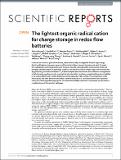The lightest organic radical cation for charge storage in redox flow batteries
Author(s)
Huang, Jinhua; Pan, Baofei; Duan, Wentao; Wei, Xiaoliang; Assary, Rajeev S.; Su, Liang; Cheng, Lei; Liao, Chen; Ferrandon, Magali S.; Wang, Wei; Zhang, Zhengcheng; Burrell, Anthony K.; Curtiss, Larry A.; Shkrob, Ilya A.; Moore, Jeffrey S.; Zhang, Lu; Brushett, Fikile R; ... Show more Show less
DownloadThe lightest organic.pdf (912.0Kb)
PUBLISHER_CC
Publisher with Creative Commons License
Creative Commons Attribution
Terms of use
Metadata
Show full item recordAbstract
In advanced electrical grids of the future, electrochemically rechargeable fluids of high energy density will capture the power generated from intermittent sources like solar and wind. To meet this outstanding technological demand there is a need to understand the fundamental limits and interplay of electrochemical potential, stability, and solubility in low-weight redox-active molecules. By generating a combinatorial set of 1,4-dimethoxybenzene derivatives with different arrangements of substituents, we discovered a minimalistic structure that combines exceptional long-term stability in its oxidized form and a record-breaking intrinsic capacity of 161 mAh/g. The nonaqueous redox flow battery has been demonstrated that uses this molecule as a catholyte material and operated stably for 100 charge/discharge cycles. The observed stability trends are rationalized by mechanistic considerations of the reaction pathways.
Date issued
2016-08Department
Massachusetts Institute of Technology. Department of Chemical EngineeringJournal
Scientific Reports
Publisher
Nature Publishing Group
Citation
Huang, Jinhua et al. “The Lightest Organic Radical Cation for Charge Storage in Redox Flow Batteries.” Scientific Reports 6.1 (2016): n. pag. © 2017 Macmillan Publishers Limited
Version: Final published version
ISSN
2045-2322